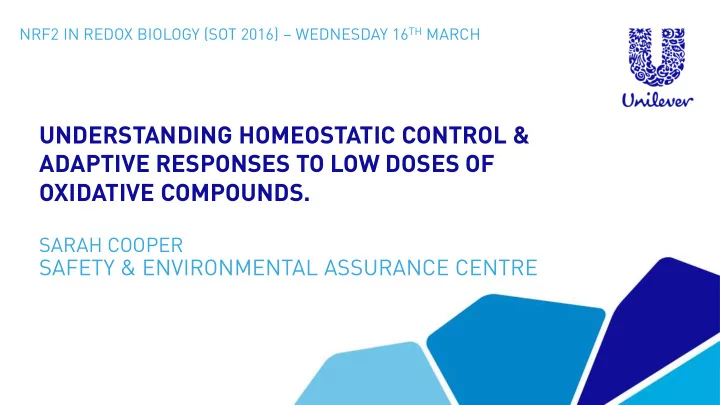

NRF2 IN REDOX BIOLOGY (SOT 2016) – WEDNESDAY 16 TH MARCH UNDERSTANDING HOMEOSTATIC CONTROL & ADAPTIVE RESPONSES TO LOW DOSES OF OXIDATIVE COMPOUNDS. SARAH COOPER SAFETY & ENVIRONMENTAL ASSURANCE CENTRE SEAC 1 Unilever Information: Internal Use
OXIDATIVE STRESS CASE STUDY • Determining the tipping-point when homeostatic regulatory mechanisms become saturated and shift from an adaptive to an adverse state is critical to define regions of safety for chemical exposure. • Oxidative stress and the role of the Nrf2 pathway in cellular defences is used as a case study to develop these approaches to enable the progression of risk assessment through mechanistic understanding of human relevant systems.
HIGH CONTENT IN VITRO ASSAY DATA
TEMPORAL ALTERATION IN NRF2 SIGNALLING RESPONSE The data highlights a 0 uM 1 uM 1.78 uM 3.16 uM 5.62 uM 10 uM temporal alteration in Nrf2 B. van de Water signaling response, moving from a low dose transient perturbation to a longer 17.8 uM 31.6 uM 56.2 uM6 100 uM 178 uM 316 uM lasting activation state at higher doses. 562 uM 1000 uM Suggests that tipping-point from adaptive to adverse could be defined based on the dose-dependent dynamics of cellular repair and recovery.
SYSTEMS BIOLOGY MODEL OF OXIDATIVE STRESS 1) FULL MECHANISTIC MODEL: Model initially tuned with public domain data available in the literature. Aim to get a ‘complete’ set of data for a range of biomarkers in HepG2 cells for 19 compounds
SYSTEMS BIOLOGY MODEL OF OXIDATIVE STRESS 2) SIMPLIFIED MECHANISTIC MODEL: Current aim is to see whether model can recapitulate the data: 5 variables (NRF2, KEAP1, GSH, ROS & SRXN1) and 30 parameters representing: Association and dissociation rates • Translation rates • Transcription rates • Turnover/removal rates • Concentration thresholds •
TRANSLATION OF IN VITRO DATA TO HUMAN IN VIVO RELEVANCE Distributions in levels of relevant biomarkers (e.g. GSH & MDA) following exercise have been taken from literature and analyzed: Idea of the human in vivo normal / homeostatic range.
SUMMARY • Determination of the tipping-point is driven by a weight of evidence – i.e. where we predict that the repair capacity of the system has been overloaded in relation to the relevant exposure scenarios for use. • To aid the translation of in vitro data for human in vivo relevance we need to compare the adaptive capacity/homeostatic range for the same biomarkers in humans. • Examining where models may help to predict the effects of chronic repeat doses & whether biomarkers stay in the homeostatic range – need to decide how complex the model needs to be.
ACKNOWLEDGEMENTS Leiden University Unilever Bob van de Water • Maja Aleksic • Stephen Winks • Paul Carmichael • Kristina Castle • Hamner Institutes Carol Courage • Melvin Andersen • Sue Edwards • Rebecca Clewell • Stephen Glavin • Bo-wen Huang • Gaurav Jain • Bin Sun • Penny Jones • Jin Li • Strand Life Sciences Alistair Middleton • Kas Subramanian • Jia Shao • Nalini R • Jayasujatha Vethamanickam • Narashima MK • Sam Windebank • Sonali Das • Andrew White •
Recommend
More recommend